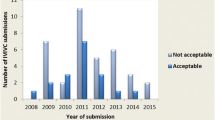Abstract
The assessment of in vivo bioequivalence (BE) of nonsystemically absorbed drug products has been a longstanding challenge facing drug manufacturers and regulators of human or animal health products. Typically, in situations where blood level BE studies are not feasible, clinical endpoint BE trials have provided the only option for generating interproduct comparisons. Given the imprecision and logistic challenges associated with these studies, there has been an effort to identify alternative pathways that can reliably ensure the equivalence of product performance and quality. This commentary provides a proposal for an in vitro approach for evaluating the in vivo BE of veterinary drug products that are either nonsystemically absorbed or that act both locally and systemically but where the local site of action is proximal to the absorption window. The assumption underlying this approach is that equivalence in product physicochemical attributes and in vitro product performance translates to equivalence in product in vivo behavior. For sponsors with a right of reference to underlying safety and effectiveness data, this approach could be used to support pre and post-approval changes. When comparing a generic test product to the pioneer (reference listed new animal drug, RLNAD) product, a demonstration of sameness across a battery of in vitro test procedures could be used to confirm that the test and RLNAD products are bioequivalent.


Similar content being viewed by others
References
Bermingham E, Del Castillo JR, Lainesse C, Pasloske K, Radecki S. Demonstrating bioequivalence using clinical endpoint studies. J Vet Pharmacol Ther. 2012;35 Suppl 1:31–7.
FDA Guidance for Industry. 2008. Waivers of in vivo animal drugs in soluble powder oral dosage form products and Type A medicated articles. Guidance #171. http://www.fda.gov/downloads/AnimalVeterinary/GuidanceComplianceEnforcement/GuidanceforIndustry/UCM052493.pdf. Accessed 18 Nov 2014.
Chang RK, Raw A, Lionberger R, Yu L. Generic development of topical dermatologic products: formulation development, process development, and testing of topical dermatological products. AAPS J. 2013;15(1):41–52.
Fahmy R, Danielson D, Martinez MN. Quality by design and the development of solid oral dosage forms. In: Rathbone MJ, McDowell A, editors. Long acting animal health drug products: fundamentals and applications. New York: Springer; 2013. p. 107–30.
Rahman Z, Xu X, Katragadda U, Krishnaiah YS, Yu L, Khan MA. Quality by design approach for understanding the critical quality attributes of cyclosporine ophthalmic emulsion. Mol Pharm. 2014;11:787–99.
FDA Guidance for Industry. 2009. ICH Q8(R2) Pharmaceutical Development. http://www.fda.gov/downloads/Drugs/%E2%80%A6/Guidances/ucm073507.pdf. Accessed 18 Nov 2014.
Dressman JB, Reppas C. In vitro-in vivo correlations for lipophilic, poorly water-soluble drugs. Eur J Pharm Sci. 2000;11 Suppl 2:S73–80.
Ameur H, Bouzit M. 3D hydrodynamics and shear rates’ variability in the United States pharmacopeia paddle dissolution apparatus. Int J Pharm. 2013;452(1–2):42–51.
Kostewicz ES, Abrahamsson B, Brewster M, Brouwers J, Butler J, Carlert S, et al. In vitro models for the prediction of in vivo performance of oral dosage forms. Eur J Pharm Sci. 2014;57:342–66.
Olejnik A, Goscianska J, Nowak I. Active compounds release from semisolid dosage forms. J Pharm Sci. 2012;101(11):4032–45.
Vertzoni M, Fotaki N, Kostewicz E, Stippler E, Leuner C, Nicolaides E, et al. Dissolution media simulating the intralumenal composition of the small intestine: physiological issues and practical aspects. J Pharm Pharmacol. 2004;56(4):453–62.
Fagerberg JH, Tsinman O, Sun N, Tsinman K, Avdeef A, Bergström CA. Dissolution rate and apparent solubility of poorly soluble drugs in biorelevant dissolution media. Mol Pharm. 2010;7(5):1419–30.
Reppas C, Friedel HD, Barker AR, Buhse LF, Cecil TL, Keitel S, et al. Biorelevant in vitro performance testing of orally administered dosage forms-workshop report. Pharm Res. 2014;31(7):1867–76.
Marques MRC, Loeberger R, Almukinzi M. Simulated biological fluids with possible application in dissolution testing. Dissolution Technologies. 2011;2011:15–25.
Lainesse C, Gehring R, Pasloske K, Smith G, Soback S, Wagner S, et al. Challenges associated with the demonstration of bioequivalence of intramammary products in ruminants. J Vet Pharmacol Ther. 2012;35 Suppl 1:65–79.
Martinez M, Amidon G, Clarke L, Jones WW, Mitra A, Riviere J. Applying the biopharmaceutics classification system to veterinary pharmaceutical products. Part II. Physiological considerations. Adv Drug Deliv Rev. 2002;54(6):825–50.
Apley M, Crist B, Gonzalez M, Hunter RP, Martinez MN, Modric S, Papich MG, Parr AF, Riviere JE, Marques MRC. Stimuli to the revision process: solubility criteria for veterinary Drugs—workshop report. Pharmacopeial Forum. 2013;(39):44–54. http://www.usp.org/sites/default/files/usp_pdf/EN/USPNF/key-issues/pf39.4_vet.pdf. Accessed 18 Nov 2014.
FDA Guidance for Industry. 1997. Dissolution testing of immediate release solid oral dosage forms. http://www.fda.gov/downloads/Drugs/GuidanceComplianceRegulatoryInformation/Guidances/UCM070237.pdf. Accessed 18 Nov 2014.
Acknowledgments
The authors would like to thank Drs. Julie Bailey and John K. Harshman for their invaluable contributions to the development of this manuscript.
Author information
Authors and Affiliations
Corresponding author
Additional information
The opinions expressed in this review by the authors do not necessarily reflect the views or policies of the Food and Drug Administration (FDA).
Rights and permissions
About this article
Cite this article
Martinez, M.N., Fahmy, R. Demonstrating Comparative In Vitro Bioequivalence for Animal Drug Products Through Chemistry and Manufacturing Controls and Physicochemical Characterization: A Proposal. AAPS J 17, 307–312 (2015). https://doi.org/10.1208/s12248-014-9702-8
Received:
Accepted:
Published:
Issue Date:
DOI: https://doi.org/10.1208/s12248-014-9702-8




